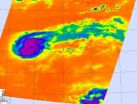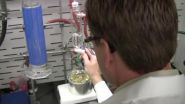(Press-News.org) A new study by researchers at Scripps Institution of Oceanography, UC San Diego, suggests that the nature of California heatwaves is changing due to global warming.
Climate researchers Alexander Gershunov and Kristen Guirguis detected a trend toward more humid heatwaves that are expressed very strongly in elevated nighttime temperatures, a trend consistent with climate change projections. Moreover, relative to local warming, the mid-summer heatwaves are getting stronger in generally cooler coastal areas. This carries implications for the millions of Californians living near the ocean whose everyday lives are acclimated to moderate temperatures.
"Heatwaves are stressful rare extremes defined relative to average temperatures," said Gershunov. "We've known for a while that humid heatwaves that are particularly hot at night are on the rise in California as the climate warms. Here, we sharpen the geographic focus to consider sub-regions of the state."
Gershunov added that in this new sharper and "non-stationary" perspective, coastal heatwaves express much more intensely than those inland where the summertime mean warming is stronger. This translates to a variety of impacts on the typically cool, un-acclimated coast.
Classic California heatwaves have been characterized as interior desert and valley events that are hot during the day and marked by dryness and strong nighttime cooling. Gershunov and Guirguis said their analysis of observations and computer model data indicates that the emerging flavor of heatwaves marked by greater humidity, greater expression in nighttime temperatures, and greater expression in coastal areas relative to the generally cooler coast are intensifying and will keep intensifying in coming decades. Both coastal and desert heatwaves will continue to be more common as climate changes relative to the past, but the desert heatwaves are becoming less intense relative to strong average warming observed and projected for the interior of the state.
The study, "California heat waves in the present and future," will appear in the American Geophysical Union journal Geophysical Research Letters.
The "non-stationary" approach reflects an acknowledgment by scientists that what has been considered extreme heat is gradually becoming commonplace. The rate of climate warming necessitates a measure of extreme heat relative to the changing average climate rather than to historical climate norms. So, instead of defining heatwaves relative to fixed temperature thresholds, the researchers projected heatwave intensity against a backdrop of increasing average summertime temperature. This causes the definition of heatwaves – temperatures in the warmest 5 percent of summertime conditions – to evolve with the changing climate and reflect extreme conditions relevant to the climate of the time.
"The advantage of using this evolving 'non-stationary' definition is that heatwaves remain extreme events even under much warmer climate," said Gershunov. "If they change in this evolving framework, it's because the variance of temperature is changing, not just the average."
The authors point out that the trend could precipitate a variety of changes in California's coastal communities, where stronger heat will lead to the installation of air conditioners in homes traditionally not in need of cooling.
This lifestyle trend would in turn affect energy demand in coastal areas, its magnitude and timing. In the absence of technological or physiological acclimatization, high humidity and the lingering of heat through the night is expected to have strong public health implications, placing added stress on many of the more than 21 million Californians who live in coastal counties. The same would be true for animals and plants living in the highly populated and diverse coastal zone.
"This trend has important human health implications for coastal California where most of the state's population lives," said Guirguis. "Coastal communities are acclimated to cooler mean temperatures and are not well prepared for extreme heat either physiologically or technologically through air conditioning use. Populations tend to adapt to changes in their average conditions but extreme events can catch people off guard. An increase in heat wave intensity relative to average conditions could mean much more heat-related illness during heat waves unless effective heat emergency plans are implemented."
### END
A study of physics faculty awareness and use of research-based instructional techniques offers greater understanding of what is missing from current education reform efforts
The world has changed dramatically in recent decades but many argue that the university system has not kept pace. As another academic year begins, if you peek into any introductory college science course you're likely to find the same scene as you would have twenty years ago: An instructor writing equations on the blackboard while a lecture hall full of students take notes.
Why is college science ...
MINNEAPOLIS / ST. PAUL (08/29/2012) —Can we have enough to eat and a healthy environment, too? Yes—if we're smart about it, suggests a study published in Nature this week by a team of researchers from the University of Minnesota and McGill University in Montreal.
Global demand for food is expected to double by 2050 due to population growth and increased standards of living. To meet this demand, it is often assumed we will need to expand the environmental burden of agriculture. The paper, based on analysis of agricultural data gathered from around the world, offers hope ...
Johns Hopkins researchers have created a synthetic protein that, when activated by ultraviolet light, can guide doctors to places within the body where cancer, arthritis and other serious medical disorders can be detected.
The technique could lead to a new type of diagnostic imaging technology and may someday serve as a way to move medications to parts of the body where signs of disease have been found. In a study published in the Aug. 27-31 Online Early Edition of Proceedings of the National Academy of Sciences, the researchers reported success in using the synthetic ...
COLLEGE STATION Aug. 29, 2012 – Analysis of a specific mutation in a gene in horses that affects the ability of horses to use alternate gaits is strongly related to racing performance and is advantageous for harness-racing horses. In domestic horses, the mutation has had a major impact on their diversification, as the altered gait characteristics of a number of breeds apparently require this mutation, according to a study that includes a Texas A&M University researcher.
Gus Cothran, a professor in the Animal Genetic Lab of the College of Veterinary Medicine & Biomedical ...
Tropical Storm Kirk looks more like a comet than a tropical storm in infrared imagery from NASA's Aqua satellite because of wind shear. NASA infrared imagery also revealed powerful thunderstorms around the center of circulation which are indicators that Kirk will continue strengthening. Meanwhile, another low pressure area appears to be organizing in the eastern Atlantic, far to the southeast of Kirk.
Tropical Depression Kirk formed from the eleventh tropical depression of the Atlantic Ocean season. Tropical Depression 11 formed on Aug. 28 at 5 p.m. EDT about 1,270 miles ...
Hurricane Isaac made two landfalls in southeastern Louisiana. Isaac's first landfall occurred in southeastern Louisiana on Aug. 28 at 7:45 p.m. EDT (1145 UTC), second landfall on Aug. 29 at 6 a.m. EDT (1000 UTC). NASA's TRMM satellite observed heavy rainfall in this slow moving storm, which leads to higher rainfall totals and flooding.
NASA and NOAA satellites continue to provide detailed information to forecasters at the National Hurricane Center. Hurricane Isaac's first landfall occurred at 7:45 p.m. EDT in extreme southeastern Louisiana, bringing strong winds and dangerous ...
WEST LAFAYETTE, Ind. –A new "nano machine shop" that shapes nanowires and ultrathin films could represent a future manufacturing method for tiny structures with potentially revolutionary properties.
The structures might be "tuned" for applications ranging from high-speed electronics to solar cells and also may have greater strength and unusual traits such as ultrahigh magnetism and "plasmonic resonance," which could lead to improved optics, computers and electronics.
The researchers used their technique to stamp nano- and microgears; form tiny circular shapes out of ...
CHICAGO --- Temper tantrums in young children can be an early signal of mental health problems, but how does a parent or pediatrician know when disruptive behavior is typical or a sign of a serious problem?
New Northwestern Medicine research will give parents and professionals a new tool to know when to worry about young children's misbehavior. Researchers have developed an easy-to-administer questionnaire specifically designed to distinguish the typical misbehavior of early childhood from more concerning misbehavior. This will enable early identification and treatment ...
(Edmonton) Danielle Peers has lived the thrill and pressure, revelled in competition and brought home hardware from the Paralympic Games. But beneath the cheers, the University of Alberta researcher questions whether the Paralympic movement is as empowering as its benevolent image.
The former Paralympian bronze medallist and women's wheelchair basketball world champion says the history of the Paralympic movement dates to the freak shows of the 19th century—and even today's modern games are a spectacle of curiosity that reinforces disability.
"The Paralympics is one ...
VIDEO:
Mark W. Lee Jr., an assistant professor of chemistry at the University of Missouri, and his research team have used carboranes to enhance cancer-fighting drugs. They recently created one drug...
Click here for more information.
COLUMBIA, Mo. -- Legend has it that Ralph Waldo Emerson once said, "Build a better mousetrap, and the world will beat a path to your door." University of Missouri researchers are doing just that, but instead of building mousetraps, the scientists ...




